
“Protecting the environment, encouraging productivity, engaging our community to ensure sustainable farming for current and future generations.”

2023 Upper Hopkins LMG President’s Report

Jack Tucker, President
Welcome to the Summer Edition of our newsletter, and thanks to Nick for compiling it!
I have received lots of enquiries regarding birds and farm habitat since our last newsletter, which is fantastic.
Due to farm related time constraints this summer’s article is a trimmed down version of my report from our recent AGM. We envisage that in Autumn we will go back to focusing on a particular Landcare topic (because we will all be sitting around looking for something to do).
Nick has made an excellent impression in his first year in the facilitator role. He has hit the ground running and with the assistance of the executive there has been a relatively seamless transition between Nick and our previous facilitator Ayesha.
Special mention should be made to Celia Tucker, Kelly Gellie and Russell Pearse who are largely responsible for organising and instigating the whole process which ultimately ended in the employment of Nick.
I would also like to formally thank Howard Brandenburg who very prepared and submitted our 2023 Victorian Landcare grant applications during the interim period where Ayesha left and Nick began.
While on thank yous, I would like to extend our thanks to the GHCMA flood recovery crew, and particularly Dave Nichols, who have completed extensive works on various properties in the time since our last AGM.

Last October Sophie Bickford facilitated a strategic planning session for the group and the ensuing document was completed earlier this year for the 2023 to 2026 period. The UHLMG 2023-2026 Strategic Plan can be read here. One of the main focuses to come out of the plan is around succession planning. Going forward it was identified that executive positions on the committee should be a maximum three-year time frame both to make these jobs less daunting for prospective people and to ensure the group remains dynamic.
2022-2023 has once again been very successful with the large number of on-farm projects being completed and some very successful gatherings organised by our Soil Health Committee. These have included a presentation by Colin Seiss in Dunkeld (in partnership with Panyyabyr Landcare and Beyond Bolac CAG), a Garden Day last Spring, a biofertiliser/compost-making workshop presented by David Hardwick at Maroona and the recent two-day field day at Chatsworth House focusing on natural capital. These events have all been really well attended and clearly there is a thirst for knowledge in the soil health space from the wider community.
I would like to make special mention of the event at Chatsworth House and thank our members Tom and Sarah Whinney. The effort they put into the event was nothing short of amazing, and aside from the networking, and the incredible amount of knowledge gained by all who attended, it really put our area, and the UHLMG, on the map.
I would like to acknowledge Celia who is stepping down from her role as Secretary. She took on the job of secretary AND treasurer with some trepidation from Peter Forster (who left very large shoes to fill!) 10 years ago in 2013. Upon her appointment I can clearly remember CC being presented with two filing cabinets full of documents, a pile of manilla folders and a swag of old charts and maps just to top it off! CC stepped down as treasurer in 2019 when the group gained the invaluable knowledge of Kelly Gellie, who took over the position. In her time as secretary (and treasurer) CC has: worked with 2 presidents and 3 facilitators (and overseen the appointment of 2 of those), successfully applied for facilitator funding umpteen times, taken the group from paper to a cloud-based digital system, instigated and overseen the first strategic plan, and now its recent update, and brought the group up to speed with Policy and Governance. This has all been on top of the usual duties of a committee secretary. I really believe CCs dedication and hard work is one of the main reasons the group is in the strong position that it is today. She will be leaving the secretary position with a clear template and process so it should be very easy for the next person to slot in and continue business as usual. On behalf of the Group, I would like to thank CC for her 10 years of hard work as group secretary!
I will finish up by reminding everyone to encourage others to join the committee as it is important that we continue to have people with a diverse range of experience and skills leading the group. Alternatively if members of our Group have a particular interest we would welcome their input big or small.
Happy Landcaring!
Jack

UHLMG July 2022 – June 2023 Impact Statement

UHLMG 2023/24 Committee Members
Welcome to all the new UHLMG committee members for the 2023-2024 period and thank you for taking the time to add your experience and skills to the Group! There are a lot of familiar faces, and a special shout out to Celia Tucker who stepped down from the role of secretary after 10 years, and congratulations and thank you to Jayne Drum for stepping into the role.

President: Jack Tucker
“I’ve always been extremely interested in nature and ecological systems. As a land manager, like all farmers, I am in a very fortunate position to be able to influence the health of the land and farm ecosystem, for my lifetime and future generations. Landcare is a way of joining forces with people with a similar outlook and creating much greater outcomes than any individual could.”

Vice President: Don Rowe
“I helped start the group way back and was initial secretary. I have also been president for quite a while. I have been growing and planting trees for nearly 50 years and have always been keen on promoting conservation of our environment.”

Secretary: Jayne Drum

Treasurer: Kelly Gellie

General Committee Member: Richard Franc
“I was born and raised in the country (Stoneleigh), and although I now happily live in Melbourne (with a great career and family) I love nothing more than leaving the city and spending time on my small holding on the banks of the Fiery Creek below Mount Cole. I became involved in Landcare because I believe the state of the environment is the biggest issue facing the world today and into the future. Landcare keeps me informed and educated on the latest local environmental issues and helps me with projects I’d otherwise struggle to complete.”

General Committee Member: Celia Tucker
“Following on from studying NRM at Uni in the early 2000’s I’ve always had a passion for catchment management, and Landcare has been a great driver in this region for achieving results on the ground on a landscape scale, which is why I’ve been keen to contribute since moving up here over a decade ago. It is satisfying to see projects completed across this region by numerous landholders and to play a role in assisting with this.”

General Committee Member: Andi Armytage

General Committee Member: Tess McDougall
“Being involved in the UHLMG is a pleasure, I have seen and heard about the great initiatives that the group has undertaken over the years and wanted to become involved. I believe I can bring a different perspective to the board, not being a landholder but being close to agriculture professionally, and I enjoy maintaining my local networks which is assisted by the group.”

General Committee Member: Tim Johnstone
“I became involved with UHLMG to help me manage soil erosion on our family farm at Maroona. I also wanted to improve the look of the farm and provide shelter for the stock. The positive impact the trees and shrubs had on birdlife is obvious and I now want to increase the habitat for birds and native animals even more. The technical and financial support of the UHLMG in helping me and many others with projects is really appreciated. The Group has created a significant impact on our district landscape.”

General Committee Member: Heidi Rees
“After moving to the area 5 years ago, I became inspired by the work the Tuckers have been doing and I am looking to get more involved in the local community. I have a science background (genetics/biochem/microbiology) and teach at local high schools so hope to combine these and learn more about our area. The last two years I have been based in the Macedon Ranges but am returning to the Ararat area next year. “
How privileged we are to have such a talented group of committee members, and to have so many community members interested in undertaking positive environmental work on their farms. Without everyone who’s gotten involved with the Group over the years, we wouldn’t be where we are today.
At our recent AGM we were lucky enough to have Dave Nichols, a well-known bird enthusiast, talk to us about Woodland Birds in a Farming Landscape. He really highlighted how special our landscape is, and how much positive impact on birdlife the farmers in our region are having. You can read some take-aways from his presentation below.
Birds in a Farming Landscape – All farms are important to birds

Dave Nichols, Bird Enthusiast and Senior Waterways Officer
Nick Moll, Landcare Facilitator
Photos by: Rob Drummond and Dave Nichols
In our region we are lucky enough to have many species of Australian birds as a common feature in our landscape; from Flame Robins to Southern Boobooks, Clamorous Reed-Warblers to Brolgas, often you only need to step outside to see, or hear, a native bird of some description. One local Ararat farmer, keeping a bird list, recorded 156 different species over an extended period. However, from historic records we know that many of our native bird species are in decline, as much of their inland woodland habitat has been reduced. It can be hard to imagine a world where they no longer exist.

Flame Robins visit our farms in winter and happily feed on crickets
A group of Brolgas recently recorded on one of the local farmsDespite the value of local, public-owned woodlands, local farms are now the pre-eminent habitat feature for most of our birds. Even farms that don’t have a lot of native vegetation can play a role in supporting grassland bird species such as Pipits and Stubble Quail. And when small birds are present, birds such as owls and other birds of prey won’t be far away. Farm dams and wetlands can also provide important habitat for many ducks, swans and other waders. Revegetated dams and creek lines with many levels of habitat such as trees, shrubs, reeds, grasses and water plants, are a unique feature in the landscape that can act as hotspots for biodiversity.
It doesn’t take much effort to improve a farm’s habitat value, such as by adding native trees and shrubs to the landscape. Even one shrub can provide nesting habitat for small birds, and the more shrubs available the more birds will have an opportunity to breed. Fairy Wrens, Scrub Wrens and a variety of Thornbills will soon show up a couple of years after the planting of a few shrubs.
Upper Hopkins farms act as important habitat, not just for local birds, but also birds that visit from other parts of Australia. Each summer there are a suite of birds that visit the western district from northern areas such as Rufous Whistlers, Sacred Kingfishers, and a number of Cuckoo species and Rufous Songlarks, to name but a few. In some seasons, as the interior dries, we welcome rarer visitors such as White-Winged Trillers and the occasional Crimson Chat. Local farms, and their dams and wetlands, also host birds that breed as far away as Siberia and the Artic Tundra, including birds such as Latham’s Snipe, Sharp-Tailed Sandpipers and Wood Sandpiper amongst a host of others. Our local farms provide valuable habitat for a significant number of bird species.
Creating and enhancing the available habitat for birds on farms and farm productivity are not mutually exclusive. Not only can you have both, but in many instances creating habitat for birds can increase productivity on farms. This is partly because of the services birds themselves provide on farms including, removing pests such as cockchafer, mice and flies, removing carrion and nutrient cycling. Ibis have been recorded eating over 250 locust, grasshoppers and cockchafer beetles in a day. Small birds such as the Striated Thornbill (pictured below) have been seen carrying many dozen fly larvae to feed their young. While Wedge-Tailed Eagles, Whistling Kites and Ravens can quickly deal with the carrion from dead livestock.

A Striated Thornbill has collected fly larvae to feed its young
Wedge-Tailed Eagle cleaning up carrionPlanting native habitat can also have benefits for livestock, such as providing shelter from chilling winds and shade from the harsh summer sun, and provide benefits for crops, such as providing shelter from extreme weather and creating microclimates for optimum growing conditions, improving soil health, increasing water penetration into soil, and maintaining soil moisture for longer periods.
One significant habitat feature on farms that can take decades, if not hundreds of years, to replace is large, old trees. Both living and dead large, hollow-bearing trees are extremely valuable to wildlife, especially birds, as breeding habitat. Hollow-bearing trees retained near revegetation projects have been shown to create very productive bird habitat. This kind of planting for enhancement also has all the benefits of tree planting mentioned above and is theorised to increase the lifespan of large, old trees.
No matter how much land you’re on, or how much native vegetation is present, all farms can provide important habitat for native birds. And with a little bit of effort this impact can be significantly increased to help keep birds in our landscape for generations to come.

Spotted Pardalotes - will 'glean' insects off eucalyptus leaves - improving the tree's health
A Crimson Chat - a very occasional visitor from inland - photo taken in MaroonaProtecting Wetlands with Precision Agriculture

Jileena Cole, Landcare Facilitator – Beyond Bolac Catchment Action Group
To bolster crop yields and preserve natural assets such as wetlands, an on-farm Precision Ag trial has begun in the district. Funded by the Glenelg Hopkins CMA ‘Our Catchment Our Communities’ program, the project is a joint effort between four Landcare networks, including Beyond Bolac Catchment Action Group, Panyyabyr Landcare Group, Upper Hopkins Land Management Group and Upper Mount Emu Creek Landcare Network.
The Beyond Bolac Catchment Action Group and Precision Agriculture have collaborated and welcomed four experienced cropping farmers to the trial: George Coutts, Graeme Vallance, Nathan Blomeley, and Simon Gabb. Each have provided a 200ha cropping area with wetlands, to be included in the trial, which aims to demonstrate how Precision Ag (PA) strategies can contribute to the protection of natural assets like wetlands while also enhancing cropping yields.
Grid soil sampling will begin in the trial areas in mid-December once the current crop is harvested. This will provide each participant with a deeper understanding of their soils and the variation across the paddocks, enabling the Precision Ag team to create custom prescription files for each area avoiding waterlogged areas. During the next planting season, machinery will be able to travel through these wetland areas without applying any seed or inputs, saving costs, and avoiding underperformance due to waterlogging.
The Precision Ag team will track the performance of each crop within the trial area to evaluate whether they can achieve a high yielding crop without the need to cultivate the wetlands using the targeted Precision Ag approach. Two on-farm field days will be held next year to showcase the trial and provide farmers with the opportunity to learn about Precision Agriculture as a tool to boost farm profitability while preserving wetlands.

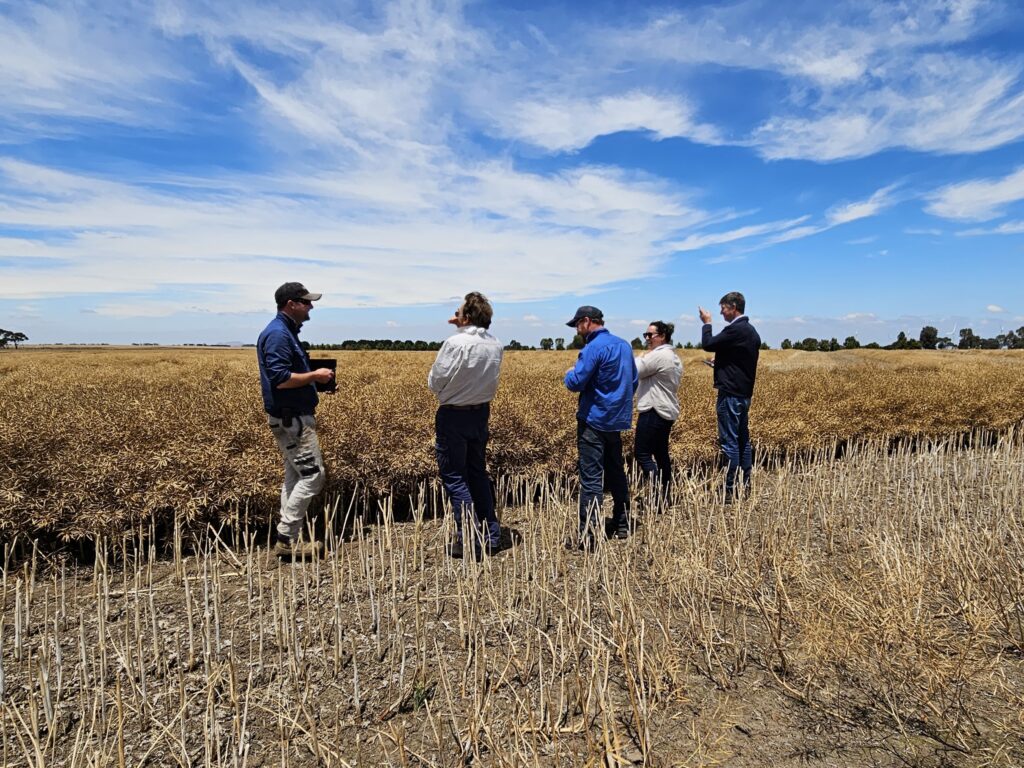
UHLMG November Garden Tour through Dunkeld

Nick Moll, Landcare Facilitator
On Friday the 17th of November twenty very enthusiastic, if not always wildly successful, gardeners caught a bus to Dunkeld for the UHLMG Garden Tour.
The weather was cool and pleasant, the views of the mountains were spectacular, and the gardens were inspiring. From the Dunkeld School Stephanie Alexander Garden, managed almost entirely by students and a few dedicated volunteers, to the Griffins Hill Yoga Retreat created by a seasoned gardener and landscape architect, to the Grampians Food Co brought to life by a farmer and a horticulturist, it truly shows that gardening is for everyone.
With many tips and tricks imparted along the way, participants drunk in the sights and witnessed first-hand all the different and creative ways produce gardens had been used to create and strengthen communities.
With a break at midday to enjoy a delicious lunch, the easy, stress-free day out left everybody with new ideas and fresh motivation for their own gardens.
We look forward to next year’s Garden Day with anticipation!
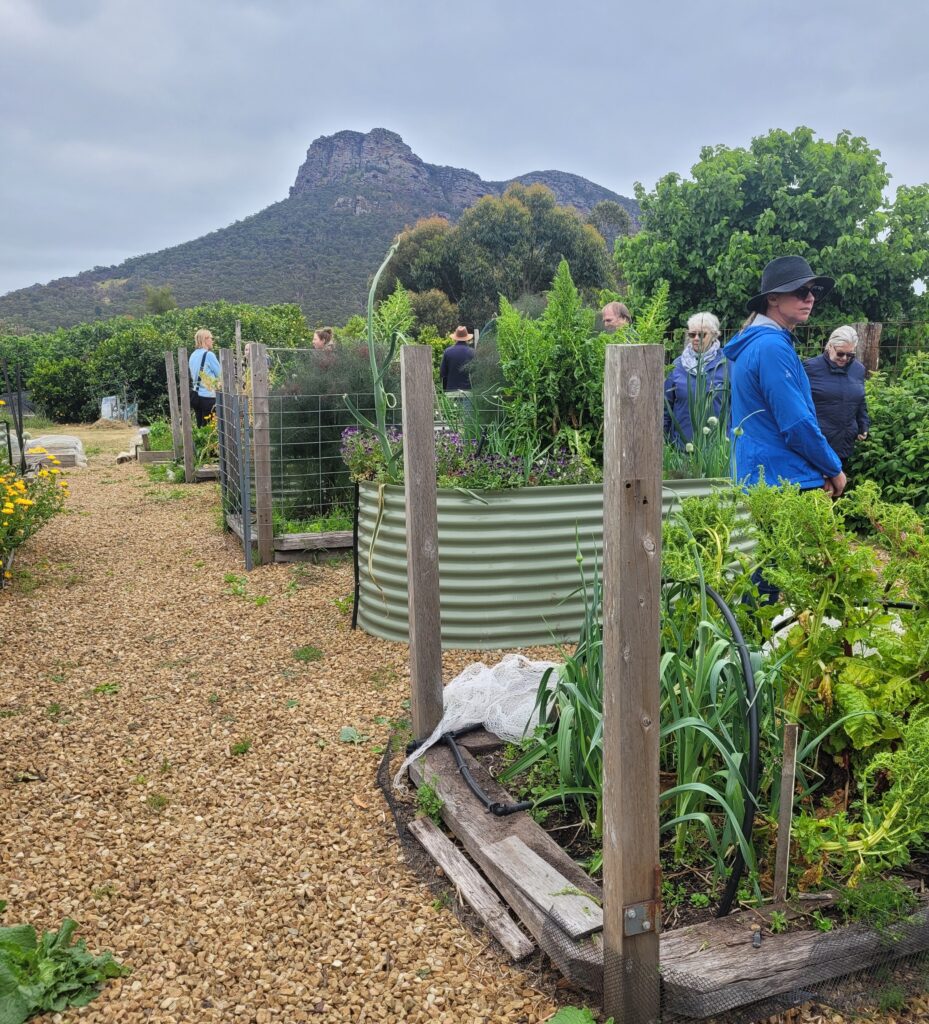
Student-managed Dunkeld School Stephanie Alexander Garden
Liv discussing their no-till system at Grampians Food Co
Commercial greenhouse setup at Grampians Food Co, what works and what didn'tChatsworth House 2023 Field Day

Sarah Whinney, Chatsworth House Pastoral
Nick Moll, Landcare Facilitator
Photos by: We Met In June photography
“Bringing Together Farm Business and Natural Capital”
Held on the 4th-5th of October this 2-day event was hosted at the beautiful property, Chatsworth House. A lively turnout of 200+ people added to the upbeat, community atmosphere. There was delicious food to be had and a wealth of knowledge held among both the guest speakers and attendees at the event.
Guest speakers included industry experts, natural capital specialists, as well as grazing and cropping farmers. They covered a wide range of topics including natural capital in the context of the global economy, building natural capital in soils, grazing management, ESG frameworks, carbon accounting and emissions reporting, carbon and biodiversity markets and what is involved in creating a successful soil carbon project.
The attendees were also privileged to hear from Shanna Wahn, CEO & Co-Founder of Sober In The Country, sharing her #ok2sayno message.
Feedback from the event was extremely positive with people highlighting the great selection of speakers, the quality of presentations and the perfect opportunity to get together, share insights and network.
Overall, an excellent outcome, helping us celebrate and connect our local farmers, while demystifying the natural capital space and building capacity and applied knowledge in our region.
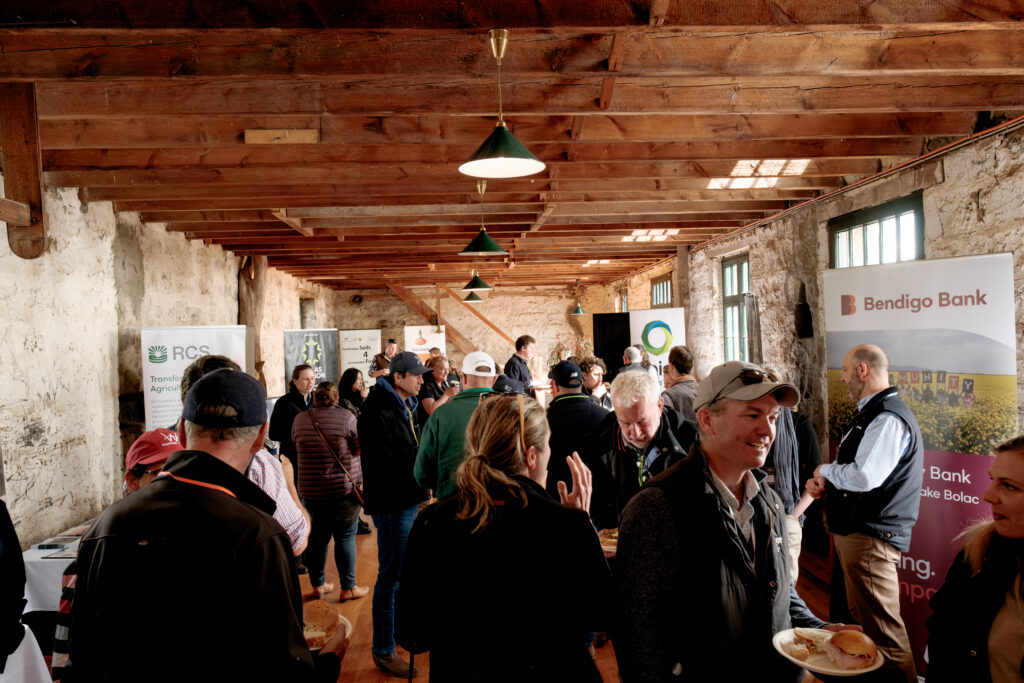
Event sponsors and lunch in the Long Room, Chatsworth House Pastoral
Afternoon tea break and networking outside the marquee
Q&A with Grant Sims, Jack Tucker, Sarah Whinney and Stuart Austin
Shanna Wahn, sharing her #ok2sayno message.
David Hardwick, presenting on soil health during the paddock walkThank you to all the amazing people involved in organising and running this event. Special mention must go to the Soil Health Committee here at UHLMG, the crew at Chatsworth House Pastoral and Anna Jamieson, who provided delicious food for all.
We are also very grateful for the generous support of our sponsors. Gold Sponsors for the event included the Glenelg Hopkins Catchment Management Authority (with funding from the Australian Government), Community Bank Willaura and Lake Bolac, Bendigo Bank, Resource Consulting Services (RCS), Atlas Carbon, Australian Soil Management and Rabobank. Supporting partners were Nutrisoil, Soil Land Food, ACE Radio and Pinion Advisory.
Perennial Pasture Systems End of Year Event

Rob Shea, Perennial Pasture Systems
Seventy members & guests attended the end of year event at PPS members’ the Curtis Family farms. A pasture tour at “Newlands” Glenpatrick started the evening & Tim and Janine showed some pretty handy pastures established in the picturesque but tough Glenpatrick Creek valley. Floods & shading of pastures by the surrounding Pyrenees Mountain Range add to the more usual issues in pasture systems but it shows that good management can overcome most problems.
It was then onto the part owned/part leased “Deer Park” farm on the Nowhere Creek where floods and kangaroos are the main production impediment but a nearly completed kangaroo fence is making things easier. Tim also gave the group a comprehensive history of the short gold rush in the Glenpatrick which was started by Chinese miners in the early 1850’s. There are still remnants of the mines including tunnels which can collapse and cause issues in paddocks. Tim told the story of rescuing his one of his daughters in her younger years when she got caught in a subsiding tunnel when helping to drove sheep; a funny story now but rather stressful at the time.
The evening finished in the magnificent gardens at the “Deer Park” homestead for dinner where a couple of the farm lambs were completing their paddock to plate journey as part of the brilliant catering by the Elmhurst Landcare group. The End of Year event was again supported by Rabobank.

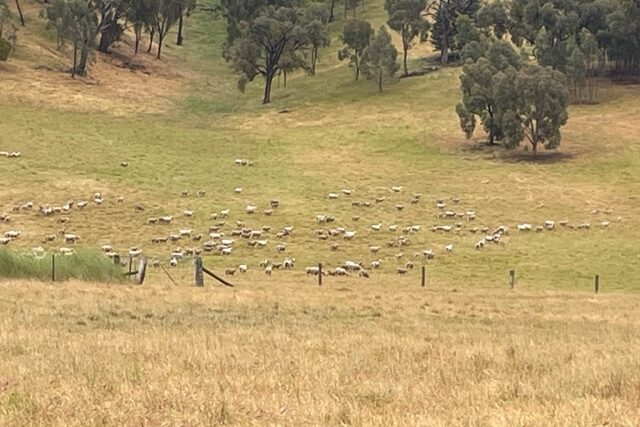

Victorian Landcare Grant Recipients

Nick Moll, Landcare Facilitator
The UHLMG has had another successful year of Victorian Landcare Grant applications with many landholders in the region expressing interest in undertaking environmental work on their properties.
3 grants have been funded in the Upper Hopkins region for the 2023-2024 VLG round:
- VLG 2023 001 Large Scale Plantings for Sustainable Futures
- VLG 2023 256 Revegetation of Stony Rises
- VLG 2023 241 Modified Farm Dams to Promote Aquatic Habitats
The 3 grants will see on-ground works funded across 7 farms with a strong focus on tree planting and farm dam revegetation and enhancement.
Thank you to Howard Brandenburg for putting together and submitting this round of applications and thank you to all the dedicated landowners improving the habitat value on their farms!
If you’re interested in applying for a Victorian Landcare Grant in 2024, please contact Nick Moll at facilitator@upperhopkins.org.au / 0400 997 204 or speak to one of our committee members.
Citizen Science Projects
The Great Southern Bioblitz
The Great Southern Bioblitz was held in from Friday the 24th of Nov to Monday the 27th Nov in 2023, with a number of citizen scientists banding together around our region to record Spring biodiversity sightings through iNaturalist. The Great Southern Bioblitz has been held every year since 2020, slowly gaining momentum throughout the Southern Hemisphere in a world-wide nature challenge.
You can participate in the 3-day challenge in your own backyard or as part of a group and record your observations. If you’re interested in getting involved, you can download the iNaturalist app to get recording and keep your eye out for next year’s Spring Bioblitz challenge!
Events, Events, Events! – See upcoming events, courses and webinars of interest below
RCS – Farming & GrazingforProfit Hamilton VIC
This 7-day RCS Farming and GrazingforProfit course is coming to Hamilton in 2024.
Running from Wed 28th of Feb 2024 – Tues 5th of March 2024 this professional development course is designed to equip producers, and those in related roles, with proven management principles that are the backbone of agricultural business success. Participants will graduate with the knowledge and practical skills to transform their business, make informed decisions, increase profitability, improve soil and plant health, maximise productivity, develop drought resilience, and optimise livestock nutrition and reproduction for highest performance.
Investment: $5,000pp Early Bird (Standard rate $5,500pp)
Further discounts for couples, groups, students and repeats.

Introduction to Environmental Markets
The Introduction to Environmental Markets Course is a practical, hands-on course for farmers, land managers, natural resource managers and supporting individuals.
The online, self-paced course covering 5 key modules focuses on participants developing the capability to identify, market and benefit from environmental market opportunities. It provides clear, practical, easy to use information about what is involved, what is good to know beforehand and how you can get started.
Investment: $490 (excl. GST) – further 20% off offer valid until 31st Dec 2023
For more information or to sign up click here.
Southern Farming Systems Events 2024
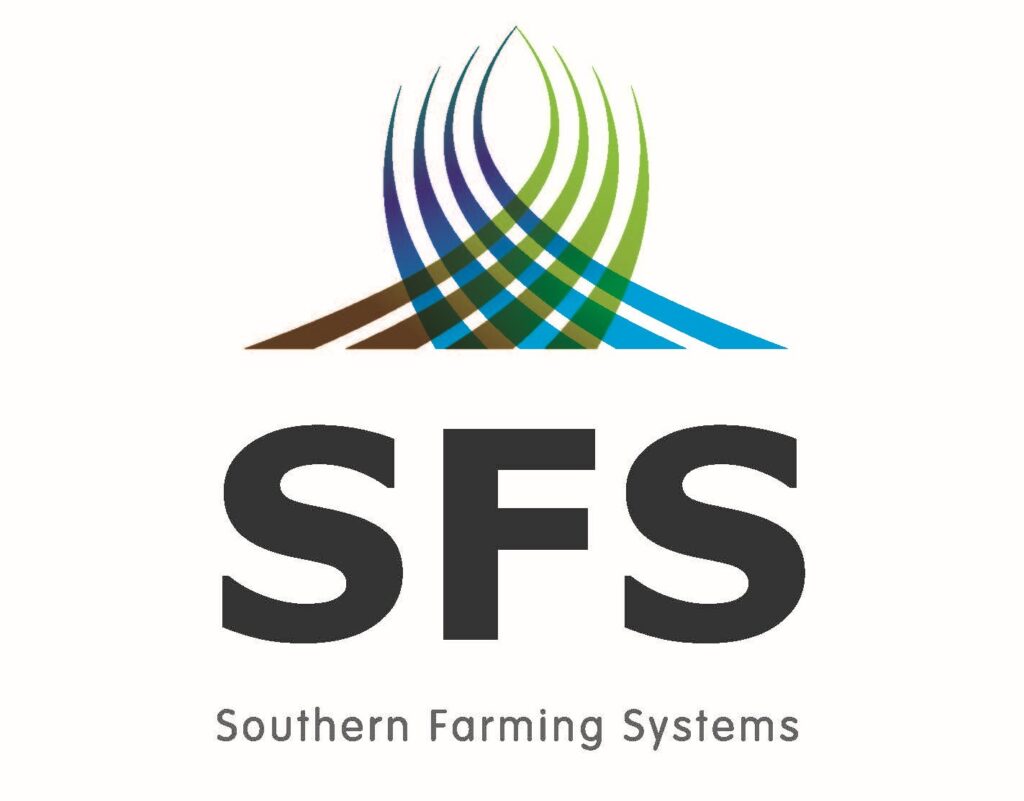
February
- TBC – Summer Fodder Walk, SFS Rokewood Trial Site
- 20 -21 – GRDC Research Update, Bendigo
- 22 – GRDC Research Update, Bannockburn
March
- 20 – Annual Trials Results Morning, Willaura
October
- 16 – AgriFocus, Streatham
FOR MORE INFORMATION OR TO REGISTER or visit www.sfs.org.au/events or contact Michelle 0488 600 692
Compost Day with David Hardwick – Save The Date

Next Eel Festival set for 22-23 March 2024 – Themed ‘Song, Story, Dance; Ceremony and Celebration’

Heliothis Monitoring 2023

Paul Horne, IPM Technologies
Nick Moll, Landcare Facilitator
Pheromone traps were setup across the local area at Willaura North, Maroona, Rossbridge and Wickliffe to monitor weekly flights of the Heliothis moth, both Helicoverpa punctigera and Helicoverpa armigera species. Results were recorded over 9 weeks, and can be viewed below.
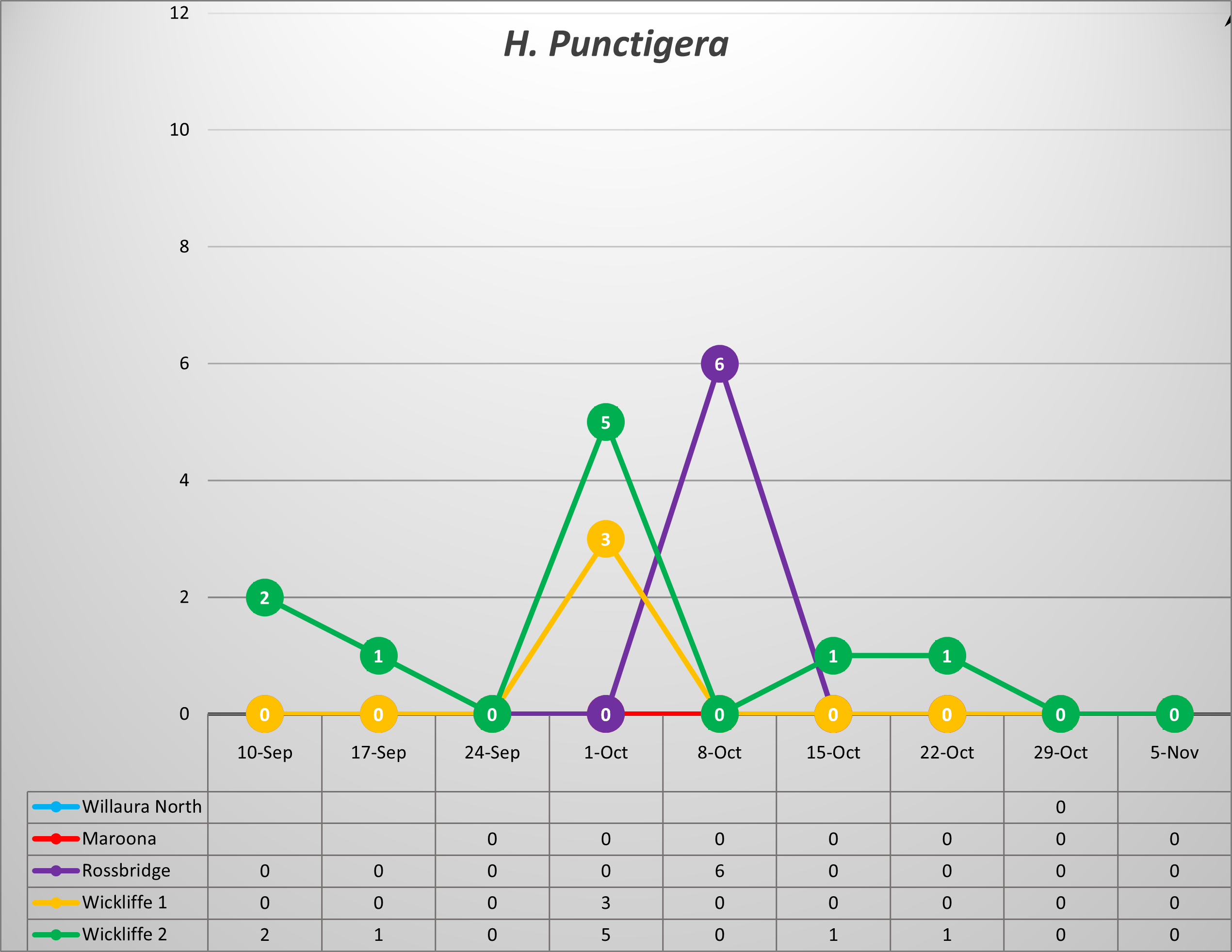

The Heliothis moth sequence is the moths fly, mate and lay eggs, then the eggs mature and hatch and then small caterpillars are present. But when they hatch, caterpillars can be very small and would be almost impossible to see on a plant (see Figure 1). So, caterpillars present now would likely come from moths flying a few weeks ago. How quickly they grow depends on the temperature.
Then the caterpillars could be H. Punctigera (easy to kill) or H. Armigera (difficult to kill, resistant to many insecticides including synthetic pyrethroids). Obviously, it would help to know what is present. H. armigera caterpillars have 4 blackspots (called the “saddle”), which on small caterpillars looks like one black area, about 1/3 of the way down their back (see Figure 2). H. Punctigera do not have these marks.


Southern Farming Systems – Strategies to get through a dry Summer

Southern Farming Systems
Merry Christmas and Happy Safe Harvest
Southern Farming Systems would like to wish you all a Merry Christmas and a happy safe harvest. Thank you to those that have supported our events throughout 2023. SFS strives to bring independent relevant research and extension for more profitable farming systems in the high rainfall zone.

Southern Farming Systems Team at AgriFocus 2023Strategies to get through a dry Summer
It is never easy making decisions in a farming business, as there is always the uncertain factor of rainfall. However, technology has allowed us to increase our knowledge with what moisture is in our soils and forecasting models have improved over time.
Tools like My Farm Dashboard allow farmers to access a number of decision support tools in one platform. It is easy to sign up, chose your location, draw in your farm boundary or import your existing farm maps, then choose what data information cards you want. This information is tailored to your location. Most of the data cards are free with some requiring third party subscriptions.
The key data cards required for creating your summer strategies are:
- Growing Season Rainfall – Reported in monthly rainfall and in long term monthly deciles where all the annual rainfall years are divided into 10 equal portions, so that Decile 1 shows the lowest 10% of rainfall records and decile 10 shows the top 10% of rainfall year records.
- Seasonal Forecast rainfall – is reported in terciles for 30, 60 or 90 day forecasts for your farm. A tercile distribution is where the predictions are divided into 3 predictions, close to average, wetter than normal or drier than normal.
- Soil moisture – links up to the nearest farm moisture probe, showing the plant available water and how this compares to last year. These are reasonably good ballpark tools.
- Pasture biomass – subscribe to the Australian Feedbase monitor (Cibolabs) for satellite estimations of feed on offer across the farm at 10 metre resolution assessments or use MyMLA for a free subscription but at reduced accuracy of one hectare resolution.
- Ag Commodity Prices – if you are thinking of selling or purchasing.
Using Rokewood as an example, the season is currently tracking close to a Decile 2 or the lowest 20% of rainfall years. In the next 30 days, the models are predicting 48% chance it will be drier, with a moderate confidence level. The plant available moisture was sitting at 70%, down by 28% compared to last year.
Using the above information with a feed budget which utilises the starting feed on offer, the expected monthly growth (which was thought to be very little given the drier seasonal forecast), estimated amount eaten by grazing stock (approximately 30kgDM/ha/month from a stocking rate of 10 DSE/ha or 1 kg DM consumed per DSE) plus 5% monthly loss in pasture decay and wastage from November through to March, allows us to predict that feed on offer will likely drop below 1000 kg DM/ha in January or February.
Knowing this allows us to plan to destock pastures to maintain groundcover. Therefore, we will need to either plan to feed stock earlier/longer than normal, reduce stock numbers or put in a fodder crop to fill this feed shortage.
You can check out the decision support tools at https://sfs.org.au/farming-systems/tools.
Southern Farming Systems – Soil your undies

Southern Farming Systems
In a recent study field trip, Cam Barr, SFS Graduate Research and Extension Officer visited the north-central and northeast NSW cropping regions and table lands surrounding the towns of Armidale, Moree and Inverell. This tour was centred around soil health and examining soil profiles across different landscapes.
Along the trip, Professor Oliver Knox, who has worked extensively in soil biology and assisting cotton growers to improve their soil productivity, introduced the group to the soil health program named ‘Soil Your Undies’, of which he has been influential in starting across Australia in conjunction with CottonInfo.
The program, which has been adapted from a similar initiative in Canada, is an engaging way of demonstrating soil microbial activity in the soil. It is a simple method that can be applied by anyone, anywhere, and has been demonstrated to more than 500 groups of Australian farmers to date.
Essentially, white pure cotton undies are buried below the soil surface for a period of 8 weeks. After this period, the undies are dug up, and varying levels of degradation can be observed depending on your soil type and microbial activity. This provides a visual representation of soil nutrient availability, organism presence and overall soil health. Professor Knox said that producers used this test alongside their soil tests as a visual marker, acting as an addition to the soil physical and chemical data detailed in their soil tests.
In further detail, the cotton fibres are made up of cellulose, which are glucose polymers pieced together. A variety of soil microbial organisms such as fungi and bacteria release cellulolytic enzymes responsible for the breakdown and cycling of these glucose polymers back into the soil system. Therefore, the more organism activity and presence in your soil system, the greater amount of breakdown of the cotton undies. The result can lead to broader considerations of your soil system, including soil pH, temperature, texture, nutrients and organic matter, which may be adjusted to influence your soil microbial population.
This is an activity you can implement on your property as well, as a visual representation of your soil health. Simply select a variety of areas across your property, with varying soil textures, colours, moisture availability, topography or crop types, and bury some 100% cotton undies in the topsoil for 8 weeks. Dig up the results and let us know how you go! Or learn more https://cottoninfo.com.au/soilyourundies.
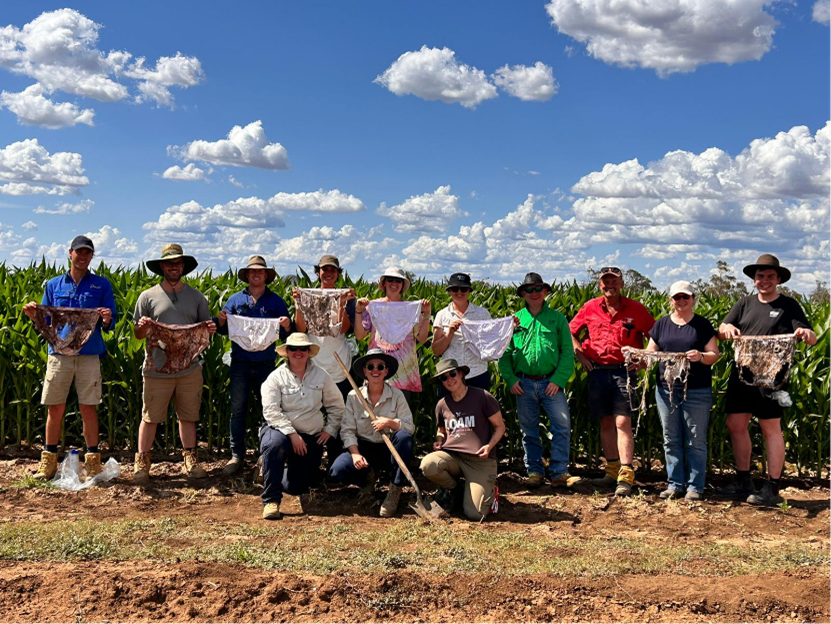
Cam Barr and the Soil Your Undies group. Source: C Barr, SFSSoil Health Week
The 5th of December to the 12th of December is Soil Week in Australia! Soil Week Australia is an initiative of Healthy Soils Australia, to raise awareness of the importance and benefits of healthy living soil. Healthy Soils Australia has compiled a list of soil health resources that may be of interest to some readers.
This includes books, videos, websites, podcasts and regenerative agriculture information. You can have a look through their recommended resources here.

IPM Checklist: a step-by-step guide for a sustainable grains industry

The National Pest Information Network has today released a new Integrated Pest Management (IPM) Checklist to demystify the processes involved in IPM and provide the Australian grains industry with clear, standardised advice.
Integrated pest management includes a range of management methods designed to suppress pest populations while reducing reliance on insecticides, especially prophylactic use and broad-spectrum products.
While the benefits of IPM strategies are widely recognised, on-farm adoption of management practices which align with IPM principles can be a challenge.
The IPM Checklist project is a component of IPMforGrains, a Grains Research and Development Corporation (GRDC) investment delivered by the National Pest Information Network. This network is led by Cesar Australia in partnership with the Queensland Department of Agriculture and Fisheries (QDAF), the Department of Primary Industries and Regional Development (DPIRD), the South Australian Research and Development Institute (SARDI), and the Department of Regional New South Wales (NSW DPI).
The aim of the checklist is to provide an overview of IPM practices and highlight which activities to focus on during different stages of the season.
As many of the management strategies outlined by the checklist are already practiced by industry, the checklist will encourage industry to take the next step towards sustainable pest management.
The IPM Checklist is designed to be a tool in pre-season farm planning, a reminder of best practice, a guide when responding to pests and an educational tool.
GRDC biosecurity manager Callum Fletcher says GRDC invested in tools, such as the IPM checklist, to ensure grain growers and their advisers had informed guidelines to support effective, best practice management.
“We understand how complex pest management can be and how important and valuable it can be to have clear recommendations to guide decision-making in the paddock,” Mr Fletcher says.
DPIRD entomologist Svetlana Micic says the IPM checklist would provide an easy framework to adopt sustainable practices for pest management.
The resource has been designed to complement the WeedSmart Big 6 as a way to help drive the promotion and acceptance of IPM practice. It was developed by a team of entomologists and extension scientists, in close consultation with agronomists from each grains region.
Agronomist Craig Davis says the IPM Checklist would be a useful tool to guide agronomists and growers how they can incorporate IPM strategies into their cropping programs.
“One benefit is they can better understand the risk of pests affecting their crops’ profitability, another is that they can reduce the risk of insecticide resistance developing on their properties,” Mr Davis says.
The checklist will continue to be updated and refined over time to ensure it accurately reflects actionable and achievable on farm practices, based on feedback from industry.
The National Pest Information Network welcomes further feedback on the checklist and input of what support would help industry implement or promote IPM via this online form.
The IPM Checklist can be accessed via the AgPest website.
Safe EC Levels For Livestock
EC values for each species of livestock denotes the level at which production decline begins:
Beef Cattle: 6,200 EC μS/cm
Lactating Ewes and Weaners: 6,000 EC μS/cm
Dry Sheep: 9,300 EC μS/cm
Horses: 6,200 EC μS/cm
Pigs: 3,100 EC μS/cm
Poultry: 3,100 EC μS/cm
Charts colour-coded: Green = Safe, Yellow = Unsafe for some species, Red = Unsafe for all livestock
Fiery Creek Sites

Hopkins River Sites
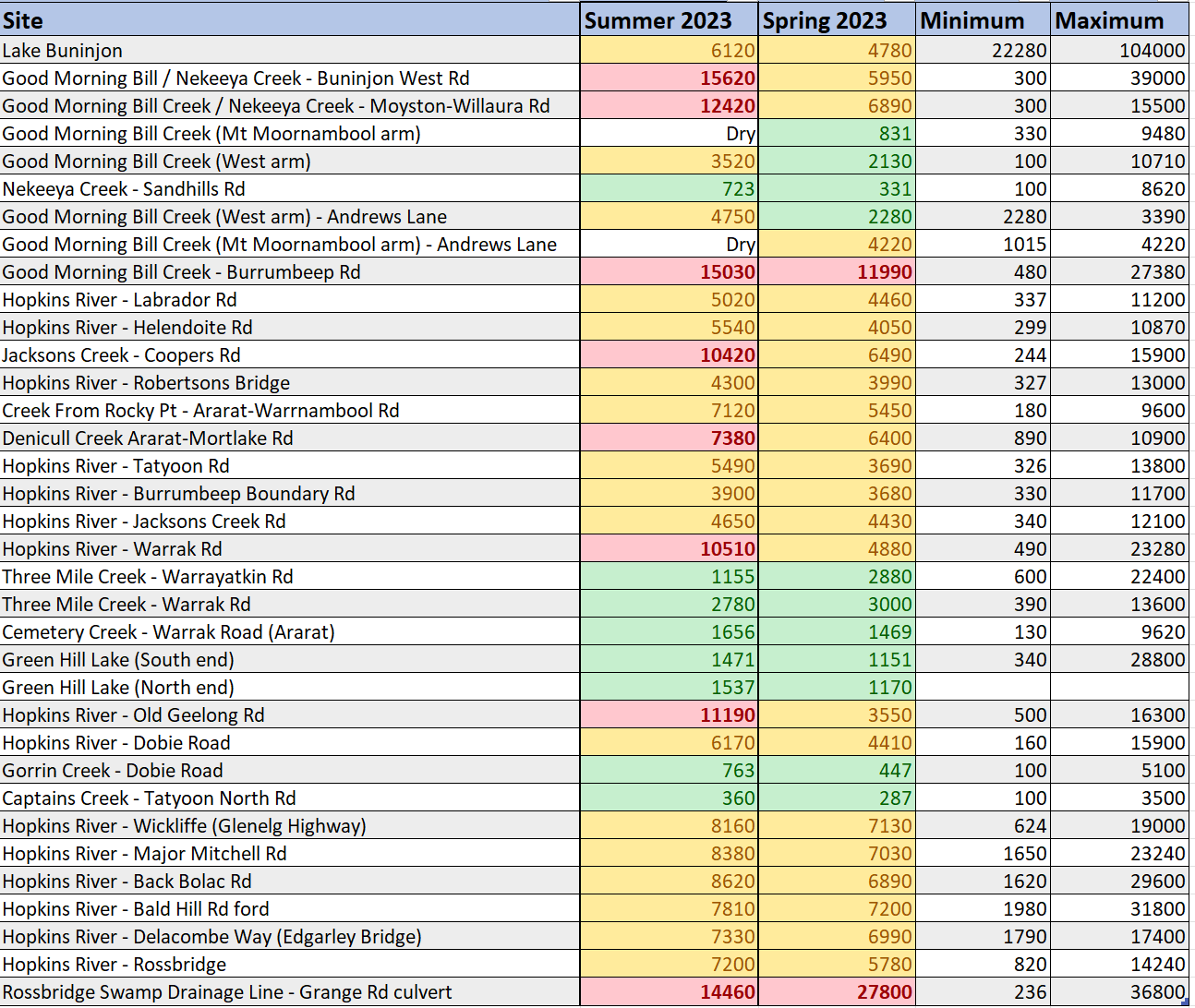
Happy Landcaring!



